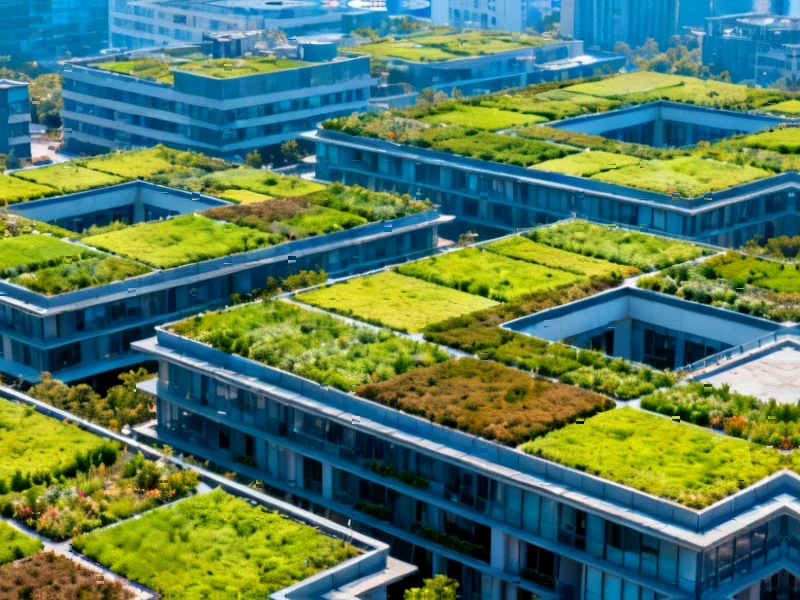Toronto’s Living Laboratory: Tracking Green Roof Health From Above
In an unprecedented urban ecology study, researchers from the University of Toronto have turned the city’s skyline into a massive environmental laboratory. Using advanced aerial imaging technology, the interdisciplinary team has conducted the most comprehensive analysis to date of how green roofs evolve and thrive in urban environments, providing crucial insights for sustainable city planning worldwide.
Table of Contents
- Toronto’s Living Laboratory: Tracking Green Roof Health From Above
- The Science Behind the Skies: Seven Years of Aerial Observation
- Surprising Findings: Green Roofs Get Better With Age
- Architectural Limitations: When Height and Shape Matter
- Plant Selection Secrets: Why Sedum Reigns Supreme
- Policy Foundations: Toronto’s Green Roof Bylaw Legacy
- Beyond Aesthetics: The Multifunctional Benefits of Green Roofs
- Future Applications: Designing Smarter Green Cities
The Science Behind the Skies: Seven Years of Aerial Observation
The research team, spanning multiple institutions including the John H. Daniels Faculty of Architecture, Landscape, and Design, analyzed multispectral airborne images captured by the City of Toronto between 2011 and 2018. What makes this study particularly groundbreaking is the extraordinary resolution of approximately seven centimeters per pixel, allowing researchers to track minute changes in vegetation health across nearly 1,500 rooftops over time.
“Being able to follow the green roofs over time gives us some real insights and guidance on how to do a better job with green roofs,” explains Sean C. Thomas, a professor at the Institute of Forestry & Conservation in the Daniels Faculty and study co-author.
Surprising Findings: Green Roofs Get Better With Age
Published in the prestigious journal Nature Cities, the research reveals two significant trends that challenge conventional wisdom about urban green infrastructure. First, vegetation health on green roofs generally improves over time, and second, the vegetation becomes less patchy as the roofs mature.
This contradicts assumptions that harsh rooftop conditions would lead to gradual degradation. However, the study did identify important exceptions that provide crucial design lessons.
Architectural Limitations: When Height and Shape Matter
The research uncovered clear patterns in underperforming green roofs that could reshape future urban planning. “It’s clear that green roofs on top of tall buildings did much worse than ones at four stories or lower,” Thomas notes. “Green roofs that are long and skinny also tend to have more degradation.”
These findings highlight the importance of considering building height and roof geometry in sustainable design, suggesting that wind exposure and microclimate conditions vary significantly with elevation and layout., according to emerging trends
Plant Selection Secrets: Why Sedum Reigns Supreme
The study provides strong evidence for the superiority of specific plant species in challenging rooftop environments. Most Toronto green roofs feature low mat-forming species like sedum, which demonstrated the best performance metrics.
Sedum’s success stems from its unique biological adaptations: extreme drought tolerance and a specialized form of photosynthesis called Crassulacean acid metabolism (CAM). This allows the plants to store atmospheric carbon dioxide at night for use in photosynthesis the following day, significantly reducing water loss during hot, dry conditions.
Policy Foundations: Toronto’s Green Roof Bylaw Legacy
This comprehensive study wouldn’t have been possible without Toronto’s pioneering environmental legislation. In 2009, Toronto became the first North American city to implement a green roof bylaw, requiring new developments larger than 2,000 square meters to dedicate part of their rooftop space to vegetation.
The policy created the perfect conditions for this long-term study, providing researchers with a diverse and substantial sample size across the urban landscape.
Beyond Aesthetics: The Multifunctional Benefits of Green Roofs
The research underscores that green roofs deliver far more than visual appeal. “With a conventional flat or slanted roof, water drains quickly off the structure in an extreme rainfall event that can overwhelm infrastructure,” Thomas explains. “Green roofs are an effective way of storing water and delaying the peak of the flood event.”
Additional benefits identified in the study include:
- Urban heat island mitigation through evaporative cooling
- Significant reduction in noise pollution
- Improved air quality through particulate filtration
- Enhanced urban biodiversity by supporting insects and birds
Future Applications: Designing Smarter Green Cities
The findings provide actionable guidance for architects, urban planners, and policymakers worldwide. By understanding which designs and plant species perform best over time, cities can optimize their green infrastructure investments for maximum environmental benefit.
As climate change intensifies urban challenges like flooding and extreme heat, this research offers evidence-based solutions for creating more resilient, sustainable cities. The aerial monitoring approach also establishes a new methodology that other cities can adopt to track and improve their own green infrastructure programs.
The study demonstrates that when science, policy, and design converge, cities can transform their skylines into living, breathing ecosystems that benefit both people and the planet.
Related Articles You May Find Interesting
- The New Ransomware Economy: Why Targeted Attacks Now Cost Millions More
- GM’s Strategic Pivot: How EV Production Adjustments Fuel Optimistic Financial Ou
- CFOs Urged to Align with Tech Leaders to Unlock AI’s Full Potential, Survey Reve
- Ocean Microbe Rivalries Unlock Secrets to Predicting Climate Shifts
- Leadership Overhaul at Novo Nordisk as Board Clashes with Foundation Over Strate
References & Further Reading
This article draws from multiple authoritative sources. For more information, please consult:
This article aggregates information from publicly available sources. All trademarks and copyrights belong to their respective owners.
Note: Featured image is for illustrative purposes only and does not represent any specific product, service, or entity mentioned in this article.



